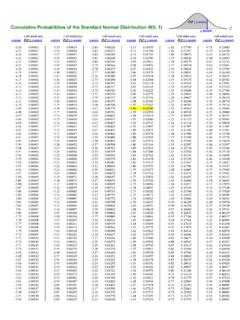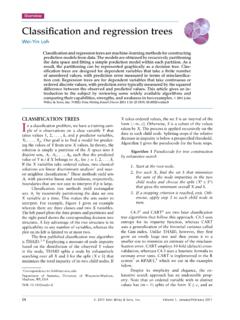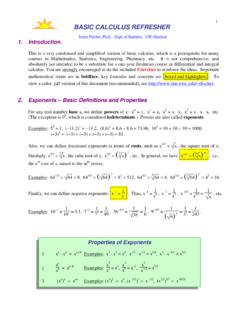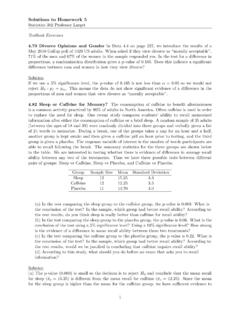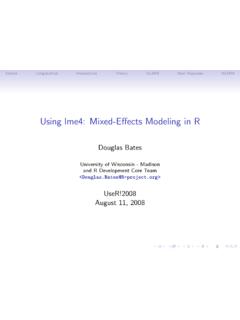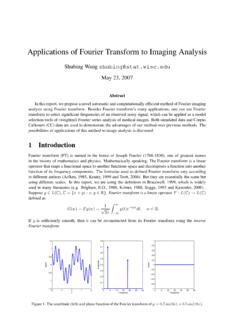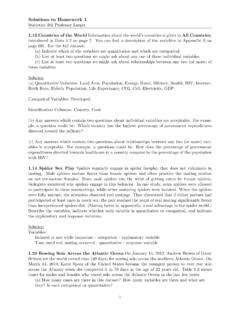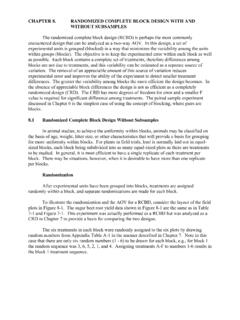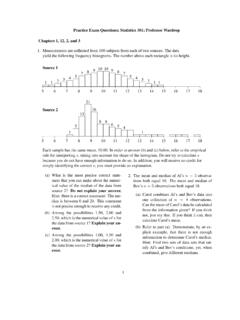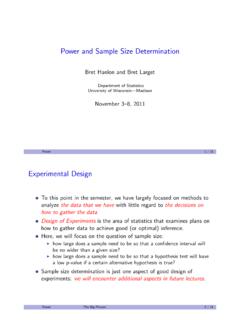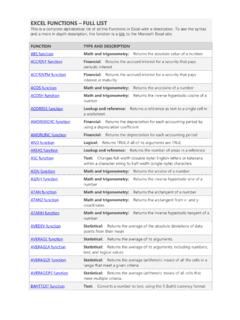Transcription of 3. The Gaussian kernel - University of Wisconsin–Madison
1 3. The Gaussian kernel "Everybody believes in the exponential law of errors: the experimenters, because they think it can be proved by mathematics; and the mathematicians, because they believe it has been established by observation" (Lippman in [Whittaker1967, p. 179]). The Gaussian kernelThe Gaussian (better Gau ian) kernel is named after Carl Friedrich Gau (1777-1855), a brilliant Germanmathematician. This chapter discusses many of the nice and peculiar properties of the Gaussian kernel .<<FEVinit ;<<FEVF unctions ;Show@ The Gaussian kernel is apparent on every German banknote of DM 10,- where it is depictednext to its famous inventor when he was 55 years old. The new Euro replaces these Gaussian kernel is defined in 1-D, 2D and N-D respectively asG1 DHx;sL=1 !!!!!!!!2p s e-x2 2s2,G2 DHx,y;sL=1 2ps2 e-x2+y2 2s2,GNDHx ;sL=1 I !
2 !!!!!!!2p sMN e- x 2 2s2 The s determines the width of the Gaussian kernel . In statistics, when we consider the Gaussian probabilitydensity function it is called the standard deviation, and the square of it, s2, the variance. In the rest of thisbook, when we consider the Gaussian as an aperture function of some observation, we will refer to s as theinner scale or shortly scale. In the whole of this book the scale can only take positive values, s>0. In theprocess of observation s can never become zero. For, this would imply making an observation through aninfinitesimally small aperture, which is impossible. The factor of 2 in the exponent is a matter of convention,because we then have a 'cleaner' formula for the diffusion equation, as we will see later on. The semicolonbetween the spatial and scale parameters is conventionally put there to make the difference between theseparameters explicit.
3 The scale-dimension is not just another spatial dimension, as we will thoroughly discussin the remainder of this NormalizationThe term 1 !!!!!!!!2p s in front of the one-dimensional Gaussian kernel is the normalization constant. It comes fromthe fact that the integral over the exponential function is not unity: - e-x2 2 s2 x= !!!!!!!!2 p s. With thenormalization constant this Gaussian kernel is a normalized kernel , its integral over its full domain is unityfor every s. This means that increasing the s of the kernel reduces the amplitude substantially. Let us look atthe graphs of the normalized kernels for s= , s=1 and s=2 plotted on the same axes:Unprotect@gaussD; gauss@x_,s_D:=1 s !!!!!!!2p ExpA-x2 2s2E;Block@8$DisplayFunction=Identity<,8p1, p2, p3<=Plot@gauss@x,s=#D,8x,-5, 5<, PlotRange->80, <D& , 1, 2<D;Show@GraphicsArray@8p1, p2, p3<D, ImageSize->8450, 130<D; The Gaussian function at scales s=.
4 3, s=1 and s=2. The kernel is normalized, so the areaunder the curve is always normalization ensures that the average greylevel of the image remains the same when we blur the imagewith this kernel . This is known as average grey level Cascade propertyThe shape of the kernel remains the same, irrespective of the s. When we convolve two Gaussian kernels weget a new wider Gaussian with a variance s2 which is the sum of the variances of the constituting Gaussians:gnewHx ;s12+s22L=g1Hx ;s12Lg2Hx ;s22L. s=.; FullSimplifyA - gauss@x,s1 Dgauss@a-x,s2D x,8s1>0, Im@s1D==0,s2>0, Im@s2D==0<E -a2 2Is12+s22M !!!!!!!!2p"################s12+s22 This phenomenon, that a new function emerges that is similar to the constituting functions , is called self-similarity. The Gaussian is a self-similar function. Convolution with a Gaussian is a linear operation, so aconvolution with a Gaussian kernel followed by a convolution with again a Gaussian kernel is equivalent toconvolution with the broader kernel .
5 Note that the squares of s add, not the s's themselves. Of course we canconcatenate as many blurring steps as we want to create a larger blurring step. With analogy to a cascade ofwaterfalls spanning the same height as the total waterfall, this phenomenon is also known as the cascadesmoothing The scale parameterIn order to avoid the summing of squares, one often uses the following parametrization: 2 s2 t, so theGaussian kernel get a particular short form. In N dimensions:GNDHx ,tL=1 HptLN 2 e-x2 t. It is this t that emergesin the diffusion equation L t= 2L x2+ 2L y2+ 2L z2. It is often referred to as scale (like in: differentiation toscale, L t), but a better name is make the self-similarity of the Gaussian kernel explicit, we can introduce a new dimensionless spatialparameter, x =x s !
6 !!!2. We say that we have reparametrized the x-axis. Now the Gaussian kernel becomes:gnHx ;sL=1 s !!!!!!!!2p e-x 2 , or gnHx ;tL=1 HptLN 2 e-x 2. In other words: if we walk along the spatial axis infootsteps expressed in scale-units (s s), all kernels are of equal size or width (but due to the normalizationconstraint not necessarily of the same amplitude). We now have a natural size of footstep to walk over thespatial coordinate: a unit step in x is now s !!!!!2 , so in more blurred images we make bigger steps. We callthis basic Gaussian kernel the natural Gaussian kernel gnHx ;sL. The new coordinate x =x s !!!!2is called thenatural coordinate. It eliminates the scale factor s from the spatial coordinates, it makes the Gaussiankernels similar, despite their different inner scales.
7 We will encounter natural coordinates many times spatial extent of the Gaussian kernel ranges from - to + , but in practice it has negligeable values for xlarger then a few (say 5) s. The numerical value at x=5s, and the area under the curve from x=5s to infinity(recall that the total area is 1):gauss@5, 1D NIntegrate@gauss@x, 1D,8x, 5, Infinity<D 10-7 The larger we make the standard deviation s, the more the image gets blurred. In the limit to infinity, theimage becomes homogenous in intensity. The final intensity is the average intensity of the image. This is truefor an image with infinite extent, which in practice will never occur, of course. The boundary has to be takeninto account. Actually, one can take many choices what to do at the boundary, it is a matter of are discussed in detail in chapter 5, where practical issues of computer implementation Relation to generalized functionsThe Gaussian kernel is the physical equivalent of the mathematical point.
8 It is not strictly local, like themathematical point, but semi-local. It has a Gaussian weighted extent, indicated by its inner scale s. Becausescale-space theory is revolving around the Gaussian function and its derivatives as a physical differentialoperator (in more detail explained in the next chapter), we will focus here on some mathematical notions thatare directly related, the mathematical notions underlying sampling of values from functions and theirderivatives at selected points ( that is why it is referred to as sampling). The mathematical functionsinvolved are the generalized functions , the Delta-Dirac function, the Heavyside function and the errorfunction. We study in the next section these functions in more we take the limit as the inner scale goes down to zero, we get the mathematical delta function, or Delta-Dirac function, d(x).
9 This function, named after Dirac (1862-1923) is everywhere zero except in x = 0, whereit has infinite amplitude and zero width, its area is 0J1 !!!!!!!!2p s e-x2 2s2N= (x) is called the sampling function in mathematics, because the Dirac delta function adequately samples justone point out of a function when integrated. It is assumed that fHxL is continuous at x=a:<< "DiracDelta " - DiracDelta@x-aDf@xD xf@aDThe sampling property of derivatives of the Dirac delta function is illustrated below: - D@DiracDelta@xD,8x, 2<Df@xD xf @0 DThe integral of the Gaussian kernel from - to x is a famous function as well. It is the error function, orcumulative Gaussian function, and is defined as:s=.;err@x_,s_D= 0x1 s !!!!!!!2p ExpA-y2 2 s2E y1 2 ErfAx !!!!2sEThe y in the integral above is just a dummy integration variable, and is integrated out.
10 The Mathematica errorfunction is Erf[x]. In our integral of the Gaussian function we need to do the reparametrization x x s !!!! we recognize the natural coordinates. The factor 1 2is due to the fact that integration starts halfway, in x= ; PlotA1 2 ErfAx s !!!!2E,8x,-4, 4<,AspectRatio->.3, AxesLabel->8"x", @xDFigure The error function Erf[x] is the cumulative Gaussian the inner scale s of the error function goes to zero, we get in the limiting case the so-called Heavysidefunction or unitstep function. The derivative of the Heavyside function is the Delta-Dirac function, just as thederivative of the error function of the Gaussian ; PlotA1 2 ErfAx s !!!!2E,8x,-4, 4<,AspectRatio->.3, AxesLabel->8"x", @xDFigure For decreasing s the Errorfunction begins to look like a stepfunction. The Errorfunction is theGaussian blurred step-edge.
